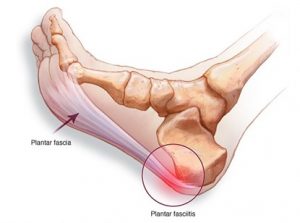Plantar Fasciitis occurs when there is inflammation of the plantar fascia at the bottom of your foot and is a common source of heel pain. So, what is fascia? Fascia is a form of connective tissue found in every part of your body running continuously from the top of your head down to your toes. While you cannot actively engage fascial tissue, it does play a role in force transfer throughout the body. There are many other functions of fascia in addition to this, but specific to the plantar fascia, its role is to support the arch and function as a shock absorber. When you consider how much time we spend on our feet and how much load, we require them to manage, foot function is incredibly important, often overlooked, and can be very frustrating when not functioning optimally.
Symptoms:
Plantar fasciitis most commonly presents as heel pain reported as a dull ache or sharp pain, and generally only affects one foot, though both feet may be implicated. Pain is often worse when getting out of bed, after resting for extended periods, post-exercise, and extended periods of standing.
Causes and predispositions:
- Middle aged men and women, though slightly more common in women
- During pregnancy
- Overweight or obese
- Long distance runners or other exercise modes due to repetitive movements and inadequate rest
- Anatomy of the feet and arches
- Other musculoskeletal predispositions including poor posterior chain (calves, hamstrings, glutes, and lower back) mobility
Why exercise with plantar fasciitis?
Not only can exercise play a role in its prevention, but exercise plays a particularly vital role in the conservative treatment of plantar fascia. Treatment will be different for everybody depending on the cause, symptoms experienced, and the tasks required i.e. An athlete compared to general population. The treatment plan will likely include multiple treatment modes including fascial release such as the use of a spiky ball, stretching, and active strengthening of the arch and intrinsic and extrinsic muscles of the feet.
Fascial release: using a spiky ball to provide the fascia with an external stimulus can help to reduce tensile pressure on the fascia and improve mobility, as well as improve circulation to the area
Stretching: stretching surrounding structures including the calves or big toe may help to address the cause of the issue and in turn help to reduce symptoms
Strengthening the foot muscles: some exercises may include calf raises, big toe extensions, toe scrunches, and arch lifts. Ensuring your foot is strong and mobile will ensure it can perform all the tasks you require of it as well as reducing stress on passive structures like the plantar fascia.
Taping: taping of the plantar fascia may also be included in a treatment plan to reduce pain and any resulting compensatory patterns to allow more normal movement patterns to continue throughout the rehabilitation
If you are currently experiencing or have experienced plantar fasciitis, consult your Exercise Physiologist for an individualised program to help you manage and reduce symptoms, and prevent recurrence.




